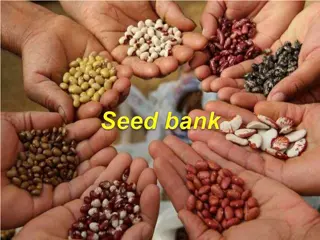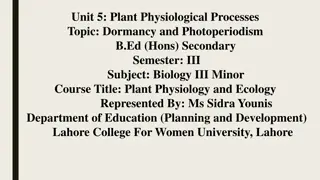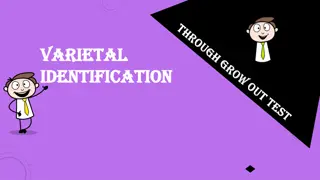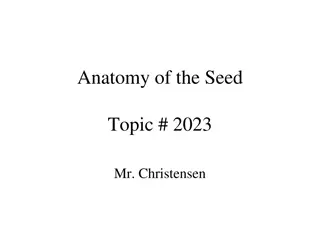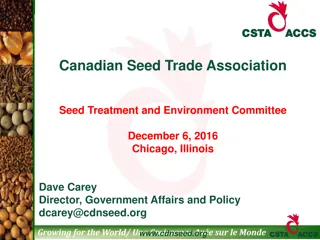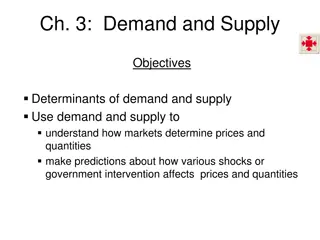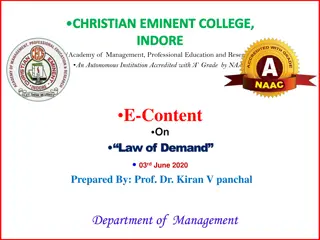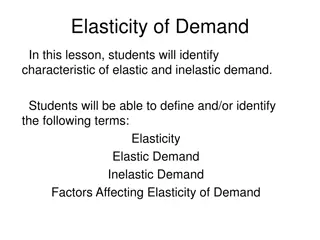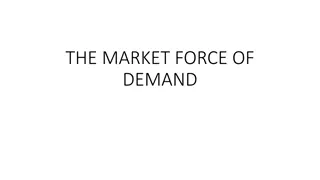Factors Affecting Seed Marketing and Demand in Agriculture Sector
Factors affecting seed marketing include clear-cut policy, availability of adapted varieties, production and storage facilities, official programs, and demand forecasting. Components such as cropping patterns, climate, market situation, and farm income levels influence seed demand. Effective demand is crucial for seed sellers to meet buyers' needs and avoid stock losses. Understanding demand factors helps improve seed marketing strategies and meet agricultural sector requirements.
Download Presentation

Please find below an Image/Link to download the presentation.
The content on the website is provided AS IS for your information and personal use only. It may not be sold, licensed, or shared on other websites without obtaining consent from the author. Download presentation by click this link. If you encounter any issues during the download, it is possible that the publisher has removed the file from their server.
E N D
Presentation Transcript
Centurion university of Centurion university of technology and management technology and management M.S.Swaminathan school of agriculture TOPIC : FACTORS AFFECTING SEED MARKETING AND TOPIC : FACTORS AFFECTING SEED MARKETING AND DEMAND. DEMAND.
Factors Affecting Seed Marketing Seed Marketing is greatly affected by the following factors: 1. Clear cut Policy: A clear- cut policy for developing the seed industry, defining the tasks and responsibilities of the official, semi-official, and private economic sectors is necessary for the development of seed marketing on sound footings. 2. Availability of well identified and Adapted Varieties. Needless to say, a seed programme would not have any impact unless superior varieties are regularly funnelled into the seed programmes. Without these, the seed marketing programme cannot expand. Current official information on new varieties that have been recommended, and released, for crop production helps in accelerating the programme. 3. Adequate production, storage and testing facilities. These are necessary for producing and maintaining seed quantities and qualities in accordance with established standards vital for the development of sound marketing. 4. Official Programme: When new varieties/ hybrids are first being introduced, particularly among small-scale farmers, the government generally has to take the initiative and promote the supply arrangement. Another important role of government is to provide market information. Another important role of government is to provide market information, to set targets and to regulate and control agencies and enterprises.
5. Demand Forecast: Realistic assessment and targets of seed demand are very necessary .Excessive quantities result in large carry-over stocks and subsequent losses, due to loss in germination and vigour of seeds, if carried over for too long. On the other hand, short supplies would deprive the seed company. The factors which affect demand Demand, to the seed seller, is the quantity that buyers are willing and able to purchase at a particular price. This is called effective demand and is not the same as the seed requirement. It is important to distinguish between the amount of seed farmers will actually buy and how much they would like to buy, or indeed how much the government would like them to buy. The total amount of certified or labelled seed sold may be quite a small proportion of the total requirement. Many factors have to be considered when assessing and forecasting demand. Some of these are: cropping pattern and intensity extension of irrigation areas; development of double cropping systems and multiple cropping of intensively grown crops; competing crops; new crops; rotations
seed use type of seed used, i.e. non-hybrid or hybrid; variations under different farming systems, such as irrigated or dry land, and grade of seed used, e.g. if seed is graded and mechanically sown climate rainfall and temperature patterns demand for crop products commodity demand; export demand; agro-industrial development market situation commodity prices; yield levels; prices of seed and other inputs and farm costs; cost of growing competing crops disposable farm income levels of farm income; what a farmer will spend on seed; availability of credit rate or level of adoption of new technology farming techniques; mechanization (precision drills use less seed); hybrids replacing non-hybrid varieties; adoption of new varieties and certified seed government policy subsidies and other inducements such as price support and credit; privatization; extension programmes; import or export policy and duty levels
crop cycles frequency of good years and poor years; occurrence of natural disasters habits and traditions socio-economic factors product performance comparison with e alternative varieties competitiveness the choice the farmer has of using alternative varieties and suppliers; how do the suppliers compare in terms of image, convenience of supply, customer support ? price how prices compare with alternative sources? Promotion special promotion campaigns being planned When an individual company or organization is estimating the market share which may be gained by its own products, product performance, competitive positioning, price and promotion are the most important factors which need to be taken into account. This will form the basis of sales' forecasting and production planning.
The effect of price and farm income on demand In general, 'the higher the price the lower the quantity purchased', especially where there are substitutes available. In the case of seed, farmers can retain the grain of non-hybrid crops, switch from hybrids to non- hybrids or grow different crops. In addition to price, farm income is the major limiting factor affecting what a farmer will spend on inputs. The farmer will have to balance the cost versus the benefit before being persuaded to spend money on inputs such as seed and fertilizers. Unfortunately, seed is often the one item that the farmer believes it is possible to save money on, even though less is usually spent on seed than on any other input. He will ask the questions: "What are the chances of getting a return on my investment?"-"Will the rains cornet:"-"What will the market be like for the produce? " It must be recognized that there are conflicting demands on farm income and the supplier of inputs is competing for that income. Marketing and promotional campaigns are designed to persuade farmers that seed represents good value. Farmers often do not attribute value to seed since, in the case of grain, they think they are producing the very product which they are being sold. Thus it would seem to many farmers that they could just as easily replant their own grain.






